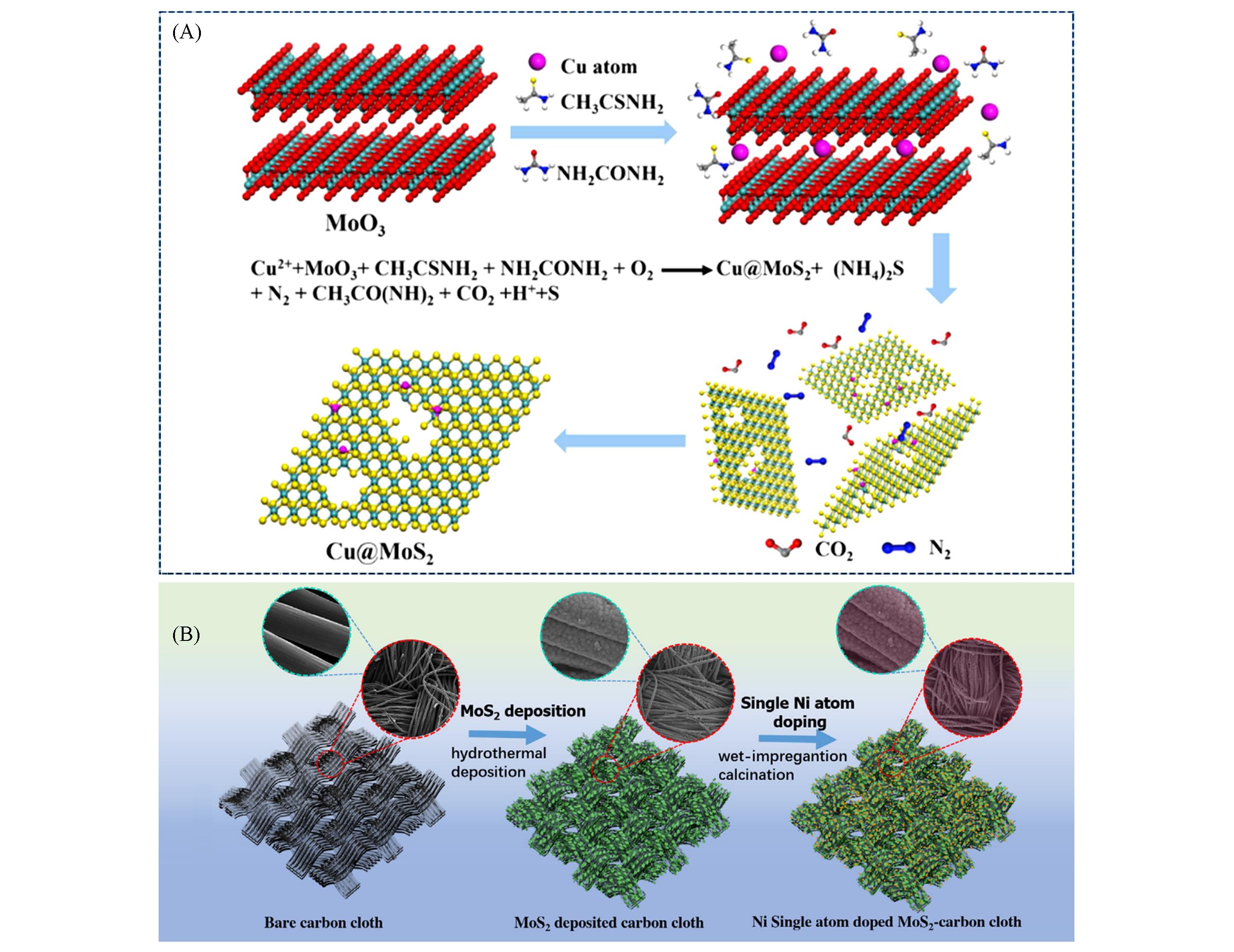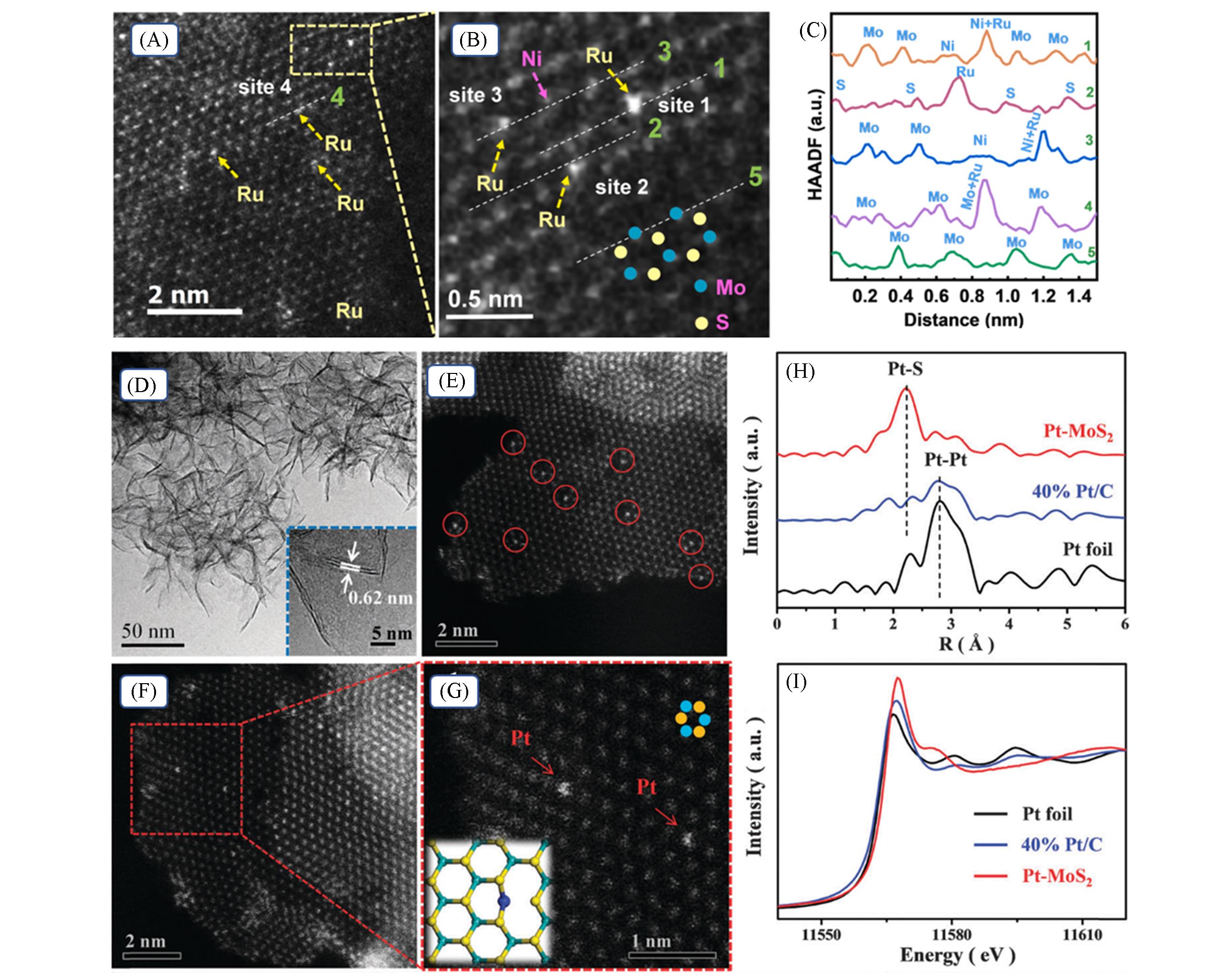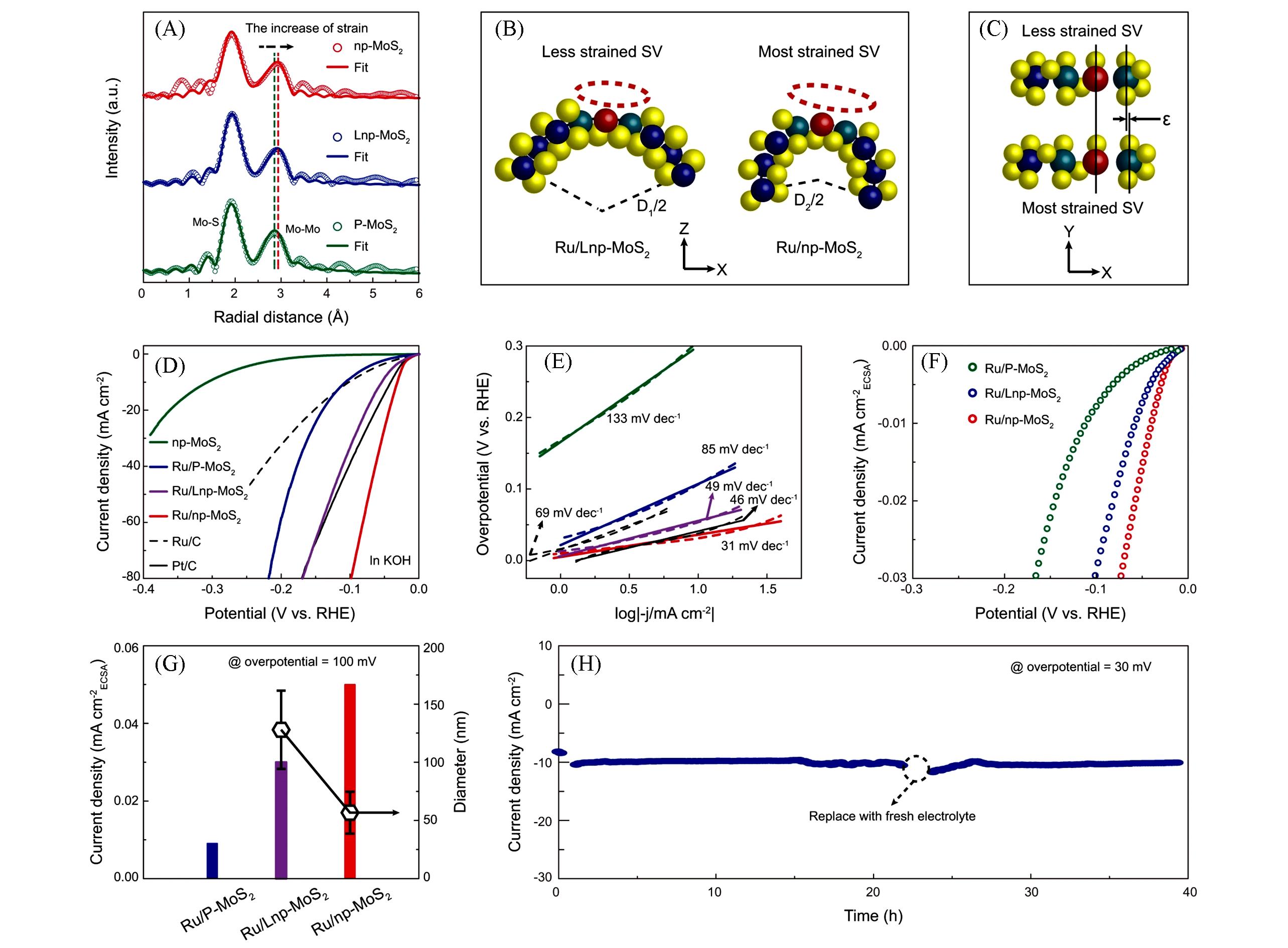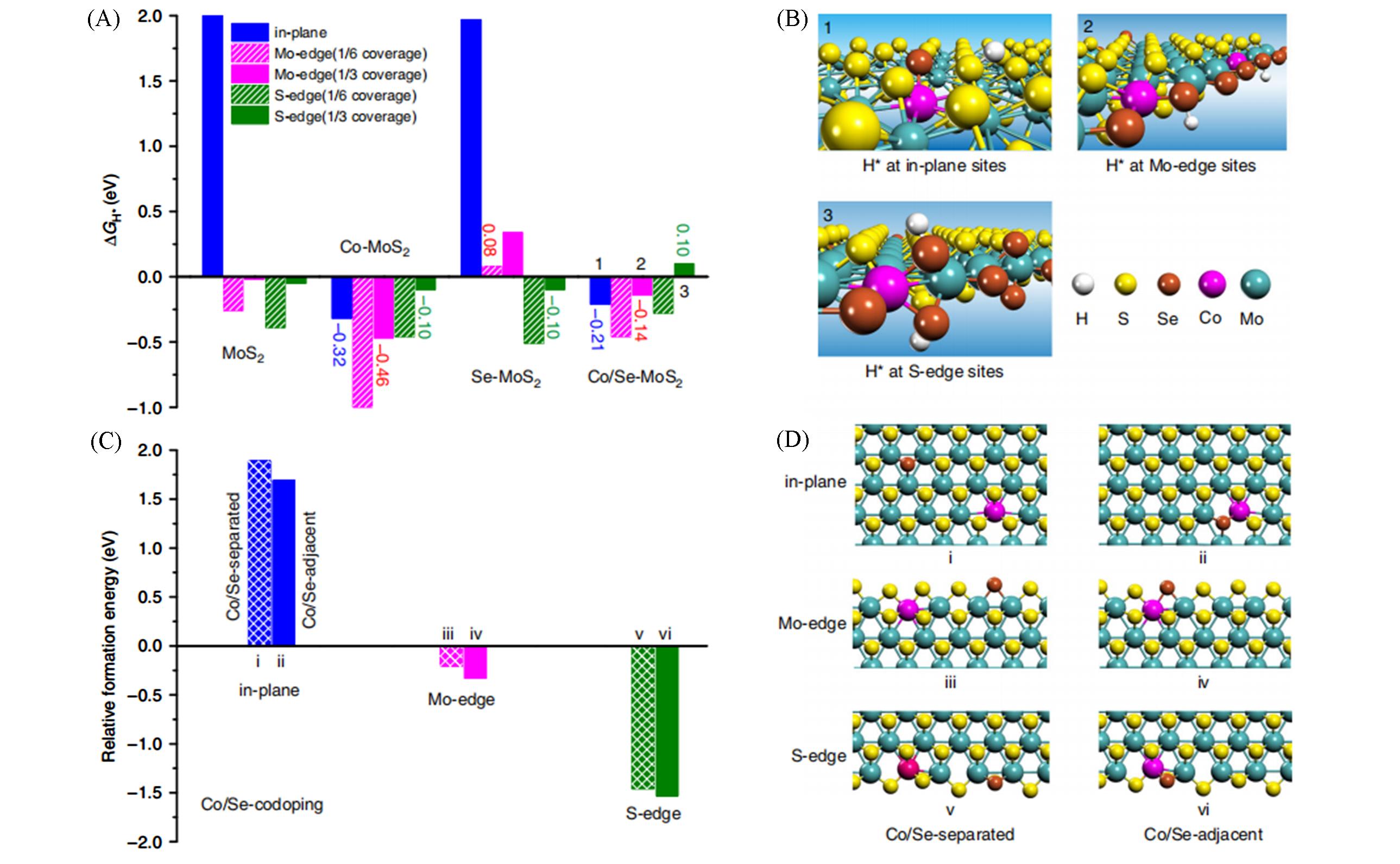

Chem. J. Chinese Universities ›› 2022, Vol. 43 ›› Issue (9): 20220321.doi: 10.7503/cjcu20220321
• Perspectives • Previous Articles Next Articles
LIN Gaoxin1,2, WANG Jiacheng1,2( )
)
Received:2022-05-10
Online:2022-09-10
Published:2022-08-05
Contact:
WANG Jiacheng
E-mail:jiacheng.wang@mail.sic.ac.cn
Supported by:CLC Number:
TrendMD:
LIN Gaoxin, WANG Jiacheng. Progress and Perspective on Molybdenum Disulfide with Single-atom Doping Toward Hydrogen Evolution[J]. Chem. J. Chinese Universities, 2022, 43(9): 20220321.

Fig.2 Active sites(edges, 1T phase, S vacancies and strain) of MoS2 for HER(A) and schematic illustration of Mo?SA?MoS2 in which Mo SAs are active sites for HER(B)[32]

Fig.3 Schematic procedure for syntheszing Cu@MoS2(A)[49] and schematic illustration of the preparation of Ni?SA?MoS2(B)[52](A) Copyright 2019, Elsevier B. V.; (B) Copyright 2018, Elsevier Ltd.
| Catalyst | Synthesis method | Overpotential(at 10 mA/cm2)/mV | Electrolyte | Ref. |
|---|---|---|---|---|
| Co?MoS2 | Hydrothermal synthesis | 47 | 0.5 mol/L H2SO4 | [ |
| Pt?MoS2 | Hydrothermal synthesis | 180 | 0.5 mol/L H2SO4 | [ |
| Ru?MoS2 | Hydrothermal synthesis | 41 | 1 mol/L KOH | [ |
| N?MoS2 | Hydrothermal synthesis | 168 | 0.5 mol/L H2SO4 | [ |
| Ni?MoS2 | Hydrothermal synthesis | 127 | 0.5 mol/L H2SO4 | [ |
| Ru, Ni?MoS2 | Wet?chemistry method | 31 | 1 mol/L KOH | [ |
| Ru?MoS2 | Wet?chemistry method | 51 | 1 mol/L KOH | [ |
| Ru?MoS2 | Wet?chemistry method | 30 | 1 mol/L KOH | [ |
| Ru?MoS2 | Wet?chemistry method | 76 | 1 mol/L KOH | [ |
| Co?MoS2 | Chemical vapor deposition | 137 | 0.5 mol/L H2SO4 | [ |
| Ru?MoS2/MoP | Galvanostatic deposition | 45 | 1 mol/L KOH | [ |
| Pt?MoS2 | Potential?cycling method | 88.4 | 1 mol/L KOH | [ |
| Pt?MoS2 | Solar irradiation | 44 | 0.5 mol/L H2SO4 | [ |
| U?MoS2 | Pulse voltammetry method | 72 | 1 mol/L KOH | [ |
Table 1 Electrocatalytic HER performance of different SAs doped MoS2
| Catalyst | Synthesis method | Overpotential(at 10 mA/cm2)/mV | Electrolyte | Ref. |
|---|---|---|---|---|
| Co?MoS2 | Hydrothermal synthesis | 47 | 0.5 mol/L H2SO4 | [ |
| Pt?MoS2 | Hydrothermal synthesis | 180 | 0.5 mol/L H2SO4 | [ |
| Ru?MoS2 | Hydrothermal synthesis | 41 | 1 mol/L KOH | [ |
| N?MoS2 | Hydrothermal synthesis | 168 | 0.5 mol/L H2SO4 | [ |
| Ni?MoS2 | Hydrothermal synthesis | 127 | 0.5 mol/L H2SO4 | [ |
| Ru, Ni?MoS2 | Wet?chemistry method | 31 | 1 mol/L KOH | [ |
| Ru?MoS2 | Wet?chemistry method | 51 | 1 mol/L KOH | [ |
| Ru?MoS2 | Wet?chemistry method | 30 | 1 mol/L KOH | [ |
| Ru?MoS2 | Wet?chemistry method | 76 | 1 mol/L KOH | [ |
| Co?MoS2 | Chemical vapor deposition | 137 | 0.5 mol/L H2SO4 | [ |
| Ru?MoS2/MoP | Galvanostatic deposition | 45 | 1 mol/L KOH | [ |
| Pt?MoS2 | Potential?cycling method | 88.4 | 1 mol/L KOH | [ |
| Pt?MoS2 | Solar irradiation | 44 | 0.5 mol/L H2SO4 | [ |
| U?MoS2 | Pulse voltammetry method | 72 | 1 mol/L KOH | [ |

Fig.4 HAADF?STEM image(A) and corresponding enlarged image(B) of Ru/Ni?MoS2, HAADF intensity line profiles taken along the appropriately numbered lines indicated in (A) and (B)(C)[60], TEM image of Pt?MoS2 with the inset showing a typical MoS2 layer distance of 0.62 nm(D), HAADF?STEM images of Pt?MoS2 showing that the single Pt atoms marked by red circles uniformly disperse in the 2D MoS2 plane(E), enlarged image showing a honeycomb arrangement of MoS2(F), and the single Pt atoms occupying the exact positions of the Mo atoms(marked by red arrows)(G), the k2?weighted EXAFS spectra(H) and the normalized Pt L3?edge XANES spectra(I)[68](G) The bottom inset shows the simulated configuration of Pt-MoS2. The green, yellow and blue balls represent Mo, S and Pt, respectively. (A)—(C) Copyright 2021, Elsevier B. V.; (D)—(I) Copyright 2015, Royal Society of Chemistry.

Fig.5 FT?EXAFS spectra(A), schematic of the atomic structure of Ru/Lnp?MoS2 and Ru/np?MoS2 derived from(A)(B, C)[? in (C) represents the amount of deformation], polarization curves(D), corresponding Tafel plots derived from (D)(E), ECSA?normalized polarization curves(F), ECSA?normalized current density at an overpotential of 100 mV(G)(the average diameters of ligaments for Ru/LnpMoS2 and Ru/np?MoS2 were also shown), and stability measurement of Ru/np?MoS2 at an overpotential of 30 mV(H)[29]

Fig.6 Adsorption free energies of H*(ΔGH*) at different catalysts(A), adsorption models of H* at different sites of Co/Se?MoS2(B), relative formation energies of the Co/Se?co?doped MoS2 with different doping configurations of Co and Se being separated(Co/Se?separated, grid bars) or adjacent (Co/Se?adjacent, solid bars) to each other(C), structures of Co/Se?co?doped basal plane, Mo?edge, and S?edge with Co/Se?separated and Co/Se?adjacent configurations(D)[86]
| 1 | Wang X. X., Swihart M. T., Wu G., Nat. Catal., 2019, 2(7), 578―589 |
| 2 | Seh Z. W., Kibsgaard J., Dickens C. F., Chorkendorff I., Nørskov J. K., Jaramillo T. F., Science, 2017, 355(6321), eaad4998 |
| 3 | Oener S. Z., Foster M. J., Boettcher S. W., Science, 2020, 369(6507), 1099―1103 |
| 4 | Zou X. X., Wu Y. Y., Liu Y. P., Liu D. P., Li W., Gu L., Liu H., Wang P. W., Sun L., Zhang Y., Chem, 2018, 4(5), 1139―1152 |
| 5 | Zhang B. W., Zhu C. Q., Wu Z. S., Stavitski E., Lui Y. H., Kim T. H., Liu H., Huang L., Luan X. C., Zhou L., Jiang K., Huang W. Y., Hu S., Wang H. L., Francisco J. S., Nano Lett., 2020, 20(1), 136―144 |
| 6 | Liu Q., Ding J., Ji G. J., Hu J. M., Gu H., Zhong Q., J. Inorg. Mater., 2021, 36(10), 1053―1058 |
| 7 | Dong M. Y., Xu W., Zhao J., Di L. B., Zhang X. L., J. Inorg. Mater., 2020, 35(5), 567―572 |
| 8 | Li Z, Ma R., Ju Q., Liu Q., Liu L., Zhu Y., Yang M., Wang J., The Innovation, 2022, 3(4), 100268 |
| 9 | Ma S., Deng J., Xu Y., Tao W., Wang X., Lin Z., Zhang Q., Gu L., Zhong W., J. Energy Chem., 2022, 3(4), 100268 |
| 10 | Wu Q. L., Luo M., Han J. H., Peng W., Zhao Y., Chen D. C., Peng M., Liu J., de Groot F. M. F., Tan Y. W., ACS Energy Lett., 2019, 5(1), 192―199 |
| 11 | Hu C., Zhang L., Gong J., Energy Environ. Sci., 2019, 12, 2620―2645 |
| 12 | Sun H. C., Tung C. W., Qiu Y., Zhang W., Wang Q., Li Z. S., Tang J., Chen H. C., Wang C. D., Chen H. M., J. Am. Chem. Soc., 2022, 144(3), 1174―1186 |
| 13 | Subbaraman R., Tripkovic D., Strmcnik D., Chang K. C., Uchimura M., Paulikas A. P., Stamenkovic V., Markovic N. D., Science, 2011, 334(6060), 1256―1260 |
| 14 | Yu Z. Y., Duan Y., Feng X. Y., Yu X. X., Gao M. R., Yu S. H., Adv. Mater., 2021, 33(31), 2007100 |
| 15 | An L., Wei C., Lu M., Liu H. W., Chen Y. B., Scherer G. G., Fisher A. C., Xi P. X., Xu Z. J., Yan C. H., Adv. Mater., 2021, 33(20), 2006328 |
| 16 | Raja Sulaiman R. R., Wong W. Y., Loh K. S., Int. J. Energy Res., 2021, 46(3), 2241―2276 |
| 17 | Wang D., Wang X., Lu Y., Song C. S., Pan J., Li C. L., Sui M. L., Zhao W., Huang F. Q., J. Mater. Chem. A, 2017, 5(43), 22618―22624 |
| 18 | Chen P. Z., Zhang N., Wang S. B., Zhou T. P., Tong Y., Ao C. C., Yan W. S., Zhang L. D., Chu W. S., Wu C. Z., Xie J., Proc. Natl. Acad. Sci. USA, 2019, 116(14), 6635―6640 |
| 19 | Li J. C., Zhang C., Ma H. J., Wang T. H., Guo Z., Yang Y., Wang Y. Y., Ma H. X., Chem. Eng. J., 2021, 414, 128834 |
| 20 | Liu Y. W., Xiao C., Huang P. C., Cheng M., Xie Y., Chem, 2018, 4(6), 1263―1283 |
| 21 | Luo Y. T., Li X., Cai X. K., Zhou X. L., Kang H. M., Liu B. L., ACS Nano, 2018, 12(5), 4565―4573 |
| 22 | Luo Z., Ouyang Y., Zhang H., Xiao M., Ge J., Jiang Z., Wang J., Tang D., Cao X., Liu C., Xing W., Nat. Commun., 2018, 9(2120), 1―8 |
| 23 | Guan J., Bai X., Tang T., Nano Res., 2022, 15(2), 818―837 |
| 24 | Wang Y., Mao J., Meng X. G., Yu L., Deng D. H., Bao X. H., Chem. Rev., 2019, 119(3), 1806―1854 |
| 25 | Wu W. Z., Niu C. Y., Wei C., Jia Y., Li C., Xu Q., Angew. Chem. Int. Ed., 2019, 58(7), 2029―2033 |
| 26 | Fu H. Q., Zhou M., Liu P. F., Yin H. J., Sun K. Z., Yang H. G., Mamun M., Hu P. J., Wang H. F., Zhou H. J., J. Am. Chem. Soc., 2022, 144(13), 6028―6039 |
| 27 | Joo J., Kim T., Lee J., Choi S., Lee K., Adv. Mater., 2019, 31(14), 1806682 |
| 28 | Yu Y., Nam G. H., He Q., Wu X. J., Zhang K., Yang Z., Chen J., Ma Q., Zhao M., Liu Z., Ran F. R., Wang X. Z., Li H., Huang X., Li B., Xiong Q., Zhang Q., Liu Z., Gu L., Du Y. H., Huang W., Zhang H., Nat. Chem., 2018, 10(6), 638―643 |
| 29 | Jiang K., Luo M., Liu Z. X., Peng M., Chen D. C., Lu Y. R., Chan T. S., de Groot F. K. M., Tan Y. W., Nat. Commun., 2021, 12(1), 1687 |
| 30 | Shang B., Ma P., Fan J., Jiao L., Liu Z., Zhang Z., Chen N., Cheng Z., Cui X., Zheng W., Nanoscale, 2018, 10(26), 12330―12336 |
| 31 | Guo Y., Yao Z., Timmer B. J. J., Sheng X., Fan L., Li Y., Zhang F., Sun L., Nano Energy, 2019, 62, 282―288 |
| 32 | Luo Y., Zhang S., Pan H., Xiao S., Guo Z., Tang L., Khan U., Ding B. F., Li M., Caai Z., Zhao Y., Lv W., Feng Q., Zou X., Lin J., Cheng H. M., Liu B., ACS Nano, 2020, 14(1), 767―776 |
| 33 | Qin Q., Chen L., Wei T., Liu X., Small, 2019, 15(29), e1803639 |
| 34 | Li Y., Gu Q., Johannessen B., Zheng Z., Li C., Luo Y., Zhang Z., Zhang Q., Fan H., Luo W., Liu B., Dou S., Liu H., Nano Energy, 2021, 84, 105898 |
| 35 | Alarawi A., Ramalingam V., He J. H., Mater. Today Energy, 2019, 11, 1―23 |
| 36 | Zhao W., Pan J., Fang Y., Che X., Wang D., Bu K., Huang f., Chem⁃Eur. J., 2018, 24(60), 15942―15954 |
| 37 | Lin G. X., Ju Q. J., Guo X. W., Zhao W., Adimi S., Ye J. Y., Bi Q. Y., Wang J. C., Yang M. H., Huang F. Q., Adv. Mater., 2021, 33(32), 2007509 |
| 38 | Jin W., Yeh P. C., Zaki N., Zhang D., Sadowski J. T., Al⁃Mahboob A., van der Zande A. M., Chenet D. A., Dadap J. I., Herman I. P., Sutter P., Hone J., Osgood R. M., Phys. Rev. Lett., 2013, 111(10), 106801 |
| 39 | Voiry D., Mohite A., Chhowalla M., Chem. Soc. Rev., 2015, 44(9), 2702―2712 |
| 40 | Kappera R., Voiry D., Yalcin S. E., Branch B., Gupta G., Mohite A. D., Chhowalla M., Nat. Mater., 2014, 13(12), 1128―1134 |
| 41 | Yan Y., Xia B. Y., Zhao B., Wang X., J. Mater. Chem. A, 2016, 4(45), 17587―17603 |
| 42 | Sheng W., Myint M., Chen J. G., Yan Y., Energy Environ. Sci., 2013, 6(5), 1509―1512 |
| 43 | Greeley J., Jaramillo T. F., Bonde J., Chorkendorff I. B., Nørskov J. K., Nat. Mater., 2006, 5(11), 909―913 |
| 44 | Hinnemann B., Moses P. G., Bonde J., Jørgensen K. P., Nielsen J. H., Horch S., Chorkendorff I., Nørskov J. K., J. Am. Chem. Soc., 2005, 127(15), 5308―5309 |
| 45 | Kang Y., Surf. Sci., 2021, 704, 121759 |
| 46 | Cui Z., Sa R., Du W., Xiao C., Li Q., Ma Z., Appl. Surf. Sci., 2021, 542, 148535 |
| 47 | Hao Y., Wang Y. T., Xu L. C., Yang Z., Liu R. P., Li X. Y., Appl. Surf. Sci., 2019, 469, 292―297 |
| 48 | Ma Z., Niu L., Jiang W., Dong C., Liu G., Qu D., An L., Sun Z., J. Phys. Mater., 2021, 4(4), 042002 |
| 49 | Ji L., Yan P., Zhu C., Ma C., Wu W., Wei C., Shen Y., Chu S., Wang J., Du Y., Chen J., Yang X., Xu Q., Appl. Catal. B: Environ., 2019, 251, 87―93 |
| 50 | Wu C., Li D., Ding S., Rehman Z. Liu Q., Chen S., Zhang B., Song L., J. Phys. Chem. Lett., 2019, 10(20), 6081―6087 |
| 51 | Zhang J., Xu X., Yang L., Cheng D., Cao D., Small Methods, 2019, 3(12), 1900653 |
| 52 | Wang Q., Zhao Z. L., Dong S., He D., Lawrence M. J., Han S., Cai C., Xiang S., Rodriguez P., Xiang B., Wang Z., Liang Y., Gu M., Nano Energy, 2018, 53, 458―467 |
| 53 | Zheng F., Huang N., Peng R., Ding Y., Li G., Xia Z., Sun P., Sun X., Geng J., Electrochim. Acta, 2018, 263, 328―337 |
| 54 | Zhu J., Tu Y., Cai L., Ma H., Chai Y., Zhang L., Zhang W., Small, 2022, 18(4), 2104824 |
| 55 | Liu M., Chen H., Tang X., Liu H., Tu B., Guo W., Zheng Y., Liu Y., Tang Y., He R., Zhu W., Small, 2022, 18(11), 2107444 |
| 56 | Qiao W., Xu W., Xu X., Wu L., Yan S., Wang D., ACS Appl. Energy Mater., 2020, 3(3), 2315―2322 |
| 57 | Wang D., Li Q., Han C., Xing Z., Yang X., Appl. Catal. B: Environ., 2019, 249, 91―97 |
| 58 | Li R., Yang L., Xiong T., Wu Y., Cao L., Yuan D., Zhou W., J. Power Sources, 2017, 356, 133―139 |
| 59 | Luo R., Luo M., Wang Z., Liu P., Song S., Wang X., Chen M., Nanoscale, 2019, 11(15), 7123―7128 |
| 60 | Ge J., Zhang D., Qin Y., Dou T., Jiang M., Zhang F., Lei X., Appl. Catal. B: Environ., 2021, 298, 120557 |
| 61 | Wang J., Fang W., Hu Y., Zhang Y., Dang J., Wu Y., Chen B., Zhao H., Li Z., Appl. Catal. B: Environ., 2021, 298, 120490 |
| 62 | Duan H., Wang C., Li G., Tan H., Hu W., Cai L., Liu W., Li N., Ji Q., Wang Y., Lu Y., Yan W., Hu F., Zhang W., Sun Z., Qi Z., Song L., Wei S., Angew. Chem. Int. Ed., 2021, 60(13), 7251―7258 |
| 63 | Besenbacher F., Lauritsen J. V., Linderoth T. R., Lægsgaard E., Vang R. T., Wendt S., Surf. Sci., 2009, 603(10), 1315―1327 |
| 64 | Asokan C., DeRita L., Christopher P., Chinese J. Catal., 2017, 38(9), 1473 |
| 65 | Rahmatullah, Qamar S., Phys. Lett. A, 2013, 377(25), 1587―1592 |
| 66 | Wei J., Qin S. N., Yang J., Ya H. L., Huang W. H., Zhuang H., Hwang B. J., Tian Z. Q., Li J. F., Angew. Chem., 2021, 133(17), 9392―9396 |
| 67 | MacArthur K. E., Pennycook T. J., Okunishi E., D'Alfonso A. J., Lugg N. R., Allen L. J., Nellist P. D., Ultramicroscopy, 2013, 133, 109―119 |
| 68 | Deng J., Li H., Xiao J., Tu Y., Deng D., Yang H., Tian H., Li J., Ren P., Bao X., Energy Environmenal Sci., 2015, 8(5), 1594―1601 |
| 69 | van Gastel R., Somfai E., van Saarloos W., Frenken J. W. M., Nature, 2000, 408(6813), 665―665 |
| 70 | Lauritsen J. V., Kibsgaard J., Olesen G. H., Moses P. G., Hinnemann B., Helveg S., Nørskov J. K., Clausen B. S., Topsøe H., Lægsgaard E., Besenbacher F., J. Catal., 2007, 249(2), 220―233 |
| 71 | Pető J., Ollár T., Vancsó P., Popov Z. I., Magda G. Z., Dobrik G., Hwang C., Sorokin P. B., Tapasztó L., Nat. Chem., 2018, 10(12), 1246―1251 |
| 72 | Fang L., Seifert S., Winans R. E., Li T., Small Methods, 2021, 5(5), 2001194 |
| 73 | Zhang T., Chen Z., Walsh A. G., Li Y., Zhang P., Adv. Mater., 2020, 32(44), 2002910 |
| 74 | Li J., Chen S., Quan F., Zhan G., Jia F., Ai Z., Zhang L., Chem, 2020, 6(4), 885―901 |
| 75 | Zhang K., Bersch B. M., Joshi J., Addou R., Cormier C. R., Zhang C., Xu K., Briggs N. C., Wang K., Subramanian S., Cho K., Fullerton⁃Shirey S., Wallace R. M., Vora P. M, Robinson J. A., Adv. Funct. Mater., 2018, 28(16), 1706950 |
| 76 | Gao X., Zhou Y., Cheng Z., Tan Y., Yuan T., Shen Z., Appl. Surf. Sci., 2021, 547, 149113 |
| 77 | Meng X., Ma C., Jiang L., Si R., Meng X., Tu Y., Yu L., Bao X., Deng D., Angew. Chem. Int. Ed., 2020, 59(26), 10502―10507 |
| 78 | Lau T. H., Wu S., Kato R., Wu T. S., Kulhavy J., Mo J., Zheng J., Foord J. S., Soo Y. L, Suenaga K., Darby M. T., Tsang S. E., ACS Catal., 2019, 9(8), 7527―7534 |
| 79 | Zhang H., Yu L., Chen T., Zhou W., Lou X. W., Adv. Funct. Mater., 2018, 28(51), 1807086 |
| 80 | Wang Y., Wang M., Lu Z., Ma D., Jia Y., Nanoscale, 2021, 13(31), 13390―13400 |
| 81 | Qi K., Cui X., Gu L., Yu S., Fan X., Luo M., Xu S., Li N., Zheng L., Zhang Q., Ma J., Gong Y., Lv F., Wang K., Huang H., Zhang W., Guo S., Zheng W., Liu P., Nat. Commun., 2019, 10(1), 5231 |
| 82 | Pan J., Song C., Wang X., Yuan X., Fang Y., Guo C., Huang F., Inorg. Chem. Front., 2017, 4(11), 1895―1899 |
| 83 | Lau T. H., Lu X., Kulhavý J., Wu S., Lu L., Wu T. S., Kato R., Foord J. S., Soo Y. L., Suenaga K., Tsang S. C. E., Chem. Sci., 2018, 9(21), 4769―4776 |
| 84 | Ren X., Ma Q., Fan H., Pang L., Zhang Y., Yao Y., Ren X., Liu S. F., Chem. Commun., 2015, 51(88), 15997―16000 |
| 85 | Liu P., Zhu J., Zhang J., Xi P., Tao K., Gao D., Xue D., ACS Energy Lett., 2017, 2(4), 745―752 |
| 86 | Zheng Z., Yu L., Gao M., Gao M., Chen X., Zhou W., Ma C., Wu L., Zhu J., Meng X., Hu J., Tu Y., Wu S., Mao J., Tian Z., Deng D., Nat. Commun., 2020, 11(1), 3315 |
| 87 | Huang Y., Sun Y., Zheng X., Aoki T., Pattengale B., Huang J., He X., Bian W., Younan S., Williams N., Hu J., Ge J., Pu N., Yan X., Pan X., Zhang L., Wei Y., Gu J., Nat. Commun., 2019, 10(1), 982 |
| [1] | TENG Zhenyuan, ZHANG Qitao, SU Chenliang. Charge Separation and Surface Reaction Mechanisms for Polymeric Single-atom Photocatalysts [J]. Chem. J. Chinese Universities, 2022, 43(9): 20220325. |
| [2] | CHU Yuyi, LAN Chang, LUO Ergui, LIU Changpeng, GE Junjie, XING Wei. Single-atom Cerium Sites Designed for Durable Oxygen Reduction Reaction Catalyst with Weak Fenton Effect [J]. Chem. J. Chinese Universities, 2022, 43(9): 20220294. |
| [3] | YANG Jingyi, LI Qinghe, QIAO Botao. Synergistic Catalysis Between Ir Single Atoms and Nanoparticles for N2O Decomposition [J]. Chem. J. Chinese Universities, 2022, 43(9): 20220388. |
| [4] | REN Shijie, QIAO Sicong, LIU Chongjing, ZHANG Wenhua, SONG Li. Synchrotron Radiation X-Ray Absorption Spectroscopy Research Progress on Platinum Single-atom Catalysts [J]. Chem. J. Chinese Universities, 2022, 43(9): 20220466. |
| [5] | WANG Sicong, PANG Beibei, LIU Xiaokang, DING Tao, YAO Tao. Application of XAFS Technique in Single-atom Electrocatalysis [J]. Chem. J. Chinese Universities, 2022, 43(9): 20220487. |
| [6] | QIN Yongji, LUO Jun. Applications of Single-atom Catalysts in CO2 Conversion [J]. Chem. J. Chinese Universities, 2022, 43(9): 20220300. |
| [7] | YAO Qing, YU Zhiyong, HUANG Xiaoqing. Progress in Synthesis and Energy-related Electrocatalysis of Single-atom Catalysts [J]. Chem. J. Chinese Universities, 2022, 43(9): 20220323. |
| [8] | FAN Jianling, TANG Hao, QIN Fengjuan, XU Wenjing, GU Hongfei, PEI Jiajing, CEHN Wenxing. Nitrogen Doped Ultra-thin Carbon Nanosheet Composited Platinum-ruthenium Single Atom Alloy Catalyst for Promoting Electrochemical Hydrogen Evolution Process [J]. Chem. J. Chinese Universities, 2022, 43(9): 20220366. |
| [9] | LIN Zhi, PENG Zhiming, HE Weiqing, SHEN Shaohua. Single-atom and Cluster Photocatalysis: Competition and Cooperation [J]. Chem. J. Chinese Universities, 2022, 43(9): 20220312. |
| [10] | HAN Fuchao, LI Fujin, CHEN Liang, HE Leiyi, JIANG Yunan, XU Shoudong, ZHANG Ding, QI Lu. Enhance of CoSe2/C Composites Modified Separator on Electrochemical Performance of Li-S Batteries at High Sulfur Loading [J]. Chem. J. Chinese Universities, 2022, 43(8): 20220163. |
| [11] | ZHAO Runyao, JI Guipeng, LIU Zhimin. Efficient Electrocatalytic CO2 Reduction over Pyrrole Nitrogen-coordinated Single-atom Copper Catalysts [J]. Chem. J. Chinese Universities, 2022, 43(7): 20220272. |
| [12] | WANG Ruhan, JIA Shunhan, WU Limin, SUN Xiaofu, HAN Buxing. CO2-involved Electrochemical C—N Coupling into Value-added Chemicals [J]. Chem. J. Chinese Universities, 2022, 43(7): 20220395. |
| [13] | WANG Lijun, LI Xin, HONG Song, ZHAN Xinyu, WANG Di, HAO Leiduan, SUN Zhenyu. Efficient Electrocatalytic CO2 Reduction to CO by Tuning CdO-Carbon Black Interface [J]. Chem. J. Chinese Universities, 2022, 43(7): 20220317. |
| [14] | YANG Lijun, YU Yang, ZHANG Lei. Construction of Dual-functional 2D/3D Hydrid Co2P-CeO x Heterostructure Integrated Electrode for Electrocatalytic Urea Oxidation Assisted Hydrogen Production [J]. Chem. J. Chinese Universities, 2022, 43(6): 20220082. |
| [15] | WANG Guangqi, BI Yiyang, WANG Jiabo, SHI Hongfei, LIU Qun, ZHANG Yu. Heterostructure Construction of Noble-metal-free Ternary Composite Ni(PO3)2-Ni2P/CdS NPs and Its Visible Light Efficient Catalytic Hydrogen Production [J]. Chem. J. Chinese Universities, 2022, 43(6): 20220050. |
| Viewed | ||||||
|
Full text |
|
|||||
|
Abstract |
|
|||||